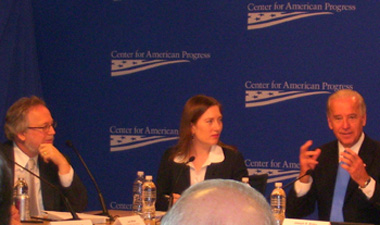On November 5, EPI co-hosted Vice President Joe Biden and a panel of economic experts to discuss the challenges of the middle class. EPI President Lawrence Mishel delivered the following remarks:
The middle class has been struggling for several decades now, and the great recession has only made matters worse. A useful way to picture the current situation of middle-class families is to imagine a rowboat in very choppy waters. Even if you are a strong rower, it is difficult if not impossible to make headway, let alone keep your boat from capsizing. For any boat to succeed, it is essential to calm the waters. But at the same time, it is also useful to assist the rower in making as much progress as possible. In this light we are here today to explain why the waters have been so choppy. As the Middle Class Task Force explores how to improve the living standards of these families, it must address both how to calm the waters and how it can help workers and their families more ably navigate them.
 What has caused the water to be so choppy for the last three decades? The relentless erosion of good quality jobs for nearly every segment of the workforce. This has been no accident: it has been the result of a policy framework that focused on lowering business costs and prices on the theory that we, as consumers, would be better off. We have introduced competition from lower-wage producers abroad, deregulated several industries, weakened labor standards such as the minimum wage and safety and health protections, poked holes in our safety net, weakened the ability of people to join unions and tolerated extended periods of high unemployment. In fact, many of these policies eroded the ability of workers to earn a decent living and generated an escalating gap between what workers produce and the wages they are paid. The consequence has been economic growth based on debt and asset bubbles, an economic model that laid the foundation for the current worldwide recession. To achieve shared prosperity, we must develop economic growth centered on good quality jobs and a typical worker’s pay rising in tandem with growing productivity.
What has caused the water to be so choppy for the last three decades? The relentless erosion of good quality jobs for nearly every segment of the workforce. This has been no accident: it has been the result of a policy framework that focused on lowering business costs and prices on the theory that we, as consumers, would be better off. We have introduced competition from lower-wage producers abroad, deregulated several industries, weakened labor standards such as the minimum wage and safety and health protections, poked holes in our safety net, weakened the ability of people to join unions and tolerated extended periods of high unemployment. In fact, many of these policies eroded the ability of workers to earn a decent living and generated an escalating gap between what workers produce and the wages they are paid. The consequence has been economic growth based on debt and asset bubbles, an economic model that laid the foundation for the current worldwide recession. To achieve shared prosperity, we must develop economic growth centered on good quality jobs and a typical worker’s pay rising in tandem with growing productivity.
The facts, as we have documented in many editions of The State of Working America, strongly support this case. With the exception of a short period during the late 1990s boom, there has been pervasive real wage stagnation over the last three decades. Most recently, in the 2000s expansion, even college-educated workers experienced flat real wages. And the erosion of employer-provided health and pension benefits is, by now, a well known part of this story.
There is no reason to believe that the economy should be blamed for the poor wage growth experienced by most workers. The fact is that the economy was able to support much better wage growth than there was. As I stated at the outset, there has been a notable gap between the wages earned by most workers and the ability of the economy to generate higher pay, as indicated by the higher production of goods and services per hour worked (productivity): over the 1979 to 2007 period, productivity grew by 71%. And as the Vice President often points out, despite solid productivity growth in the last expansion, middle-income, working-age households actually somehow lost ground.
Clearly, the benefits of productivity growth have largely flowed upward. Those in the upper 1% of earners saw their annual salaries rise by 158% from 1979 to 2007, while those at the very top of that group had salary increases of 361%. In contrast the bottom 90% of the workforce saw their annual salaries grow by just 16%, with nearly all of that occurring in the late 1990s boom.
Nor can the wage challenges experienced by the workforce be attributed to inadequate education or skills. In 1979, only 19% of the workforce had a college education and 20% failed to complete high school or have a GED. In 2007, 31% of the workforce had a college degree or more, and less than 10% failed to complete high school. Moreover, we have seen that wage stagnation has affected even those with four-year college degrees and the earnings and benefits obtained by new college graduates are lower in each succeeding year.
As the president has said, we do need to develop a new foundation for growth. This means enhancing our productivity growth and transitioning to a low-carbon economy. But it also means a relentless focus on generating quality jobs and building an economy where all of the workforce will benefit from rising productivity.
